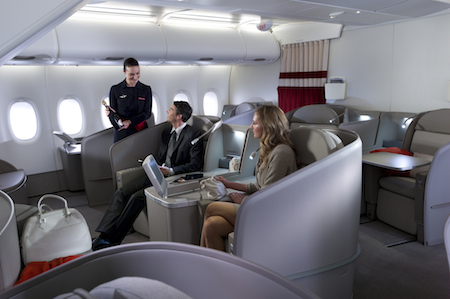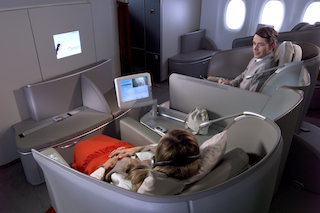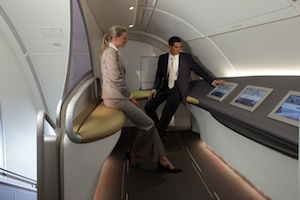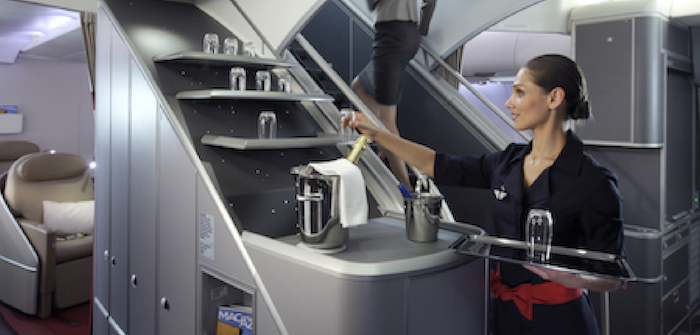With the arrival of its seventh and eighth A380s at the end of May 2012, Air France unveiled its new Première and Classe Affaires cabins at the heart of an ambitious policy to move upmarket and remain competitive in the luxury market.

“With satisfaction extremely high in Voyageur [economy] class, the challenge came more from the high end,” says Carole Peytavin, vice president of marketing R&D at Air France, of a cabin design that was already seven years old by the time it came into service in 2009. Priority went to modifying the nine seats in La Première (first class), while meeting the constraint of keeping to the original footprint, in what was virtually a bespoke refit for an estimated cost of €200,000 per seat, compared with around €60,000 for the original seats.
In fact, it has been an ongoing upgrade – the Premium Voyageur (premium economy) cabin was added to the fifth A380, new flat bed seats in Classe Affaires (business class)for the sixth A380, and the restyled La Première Cabin for the seventh and eighth, with four more aircraft to arrive during 2013 and 2014, the forerunner of a “significant upgrade” of first and business classes across much of the fleet.
Air France brought in the Yellow Window design consultancy (the Parisian subsidiary of Enthoven Group) – which had previously worked with Air France on the bar of the Boeing 777-300 – to redesign La Première, with a double brief to meet the demand for improved comfort and create a style to suit the image of luxury travel and market demand for unique spaces like boutique hotels.
“They [Air France] considered that the first-class style no longer corresponded with their status,” says Patricia Bastard, director of Yellow Window. “They wanted something more slender and lighter, that corresponded with an image of Air France Première that is feminine, refined, French, open and spacious.”
As a result of passenger surveys and consultation with customer feedback groups who said, “We want more privacy, but we don’t want an enclosed space,” an open seat was chosen, providing, as Peytavin puts it, a European halfway house between the enclosed suite favoured by Asian and Middle Eastern airlines, and the open cabins appreciated by North and South American customers.
 Inspired by a blooming tulip, the new seat enables travellers on one hand to “appreciate the space of the A380, and on the other a more intimate space when you are seated,” says Bastard. “You feel really protected, you can’t be seen by others, and when you sleep you are more protected from people passing through the corridors.
Inspired by a blooming tulip, the new seat enables travellers on one hand to “appreciate the space of the A380, and on the other a more intimate space when you are seated,” says Bastard. “You feel really protected, you can’t be seen by others, and when you sleep you are more protected from people passing through the corridors.
“An aircraft cabin is still quite a confined space. If one makes enclosed suites, even using luxurious materials, it will never be very qualitative,” continues Bastard, “so the choice we made with Air France is to consider that, after all, the voyagers who are in Classe Première belong to the same world and should not be enclosed; on the contrary we should play on the space, opening up the cabin to give the sentiment of being at home in the ‘maison France’.
“They brought us in to work on the design, knowing that we must rework the design in improving the seat and completely change its appearance, but without changing the technical specifications,” adds Bastard.
Timber!
Yellow Window developed the first class seat in collaboration with Contour, the manufacturer of the original seat. Although overall dimensions remain the same – each seat converts into a 2m-long (82in) fully flat bed that is 61cm (24in) wide to save the time and expense of homologation – the weight was reduced by reducing the trimmings on the shell. “Technically it has kept the structure of the earlier seat, but in terms of volume and image we have changed it considerably, with a much more open design, and an improved ergonomy through slimmer headrests, adjustments to the seats, and wider armrests,” explains Bastard. “There is also a more luxurious stitched leather, and we have taken out all the fake wood that gave it a downmarket feel, and the colour has changed to a patchwork of warm greys and touches of red. We also completely reworked the privacy screen, making it much larger to give a seat that is open on the cabin, while allowing privacy inside.”
With sockets and cables hidden away, Yellow Window prioritised looks over technology in deliberate contrast to the technical, functional style of business class. “We were determined to make the technology disappear as much as possible, so we rethought the control panel for the seat, as well as the reading light. Although we are in an aircraft that is evidently pretty technical, the aim is to make it as user-friendly and accessible as possible,” explains Bastard.
Air France also took the opportunity to redesign the colours inside the cabin, moving from a dominant beige to softer, warmer greys. “To give a sense of luxury when travelling first class, we used white and grey that are linked to Air France, with light colours that also increase the feeling of space,” says Peytavin.
Meanwhile in Classe Affaires (business class), located on the upper deck, Air France has introduced a new longer and wider ‘full-sleep’ seat manufactured by B/E Aerospace, gradually being introduced on the A380 and B777 between 2011 and 2013, while preserving the same footprint in a 2-2-2 configuration, with a generous 2m bed length. A removable armrest makes the seat accessible for reduced mobility passengers, while a fixed footrest allows additional storage space in the seat back.
Café culture
Has the size and the layout of the A380 changed the way passengers behave? Air France conceived the voyage as “a spatial experience,” says Peytavin. “We designed the A380, which is a big aircraft, to give you the sort of pleasure experience you used to get when travelling across the Atlantic on a cruise liner.”
 Like on an early Transatlantic liner, passengers can promenade around the aircraft and between decks, while preserving a similar notion of separation between the classes. Thus La Première passengers travelling on the main deck can climb the wide, curved staircase reserved exclusively for them at the front, up to the first-class bar and the Galerie d’Art (pictured right), reserved for Première and Classe Affaires, where exhibitions are presented on video in association with major museums. As seats are spread over both decks, passengers in Voyageur class can still move between the levels by using the stairs at the rear. The six bars (one in La Première, two in Classe Affaires and three in Premium Voyageur and Voyageur classes) play a key role in what Peytavin sees as a characteristically French touch of conviviality and café culture, a place where passengers – both business and leisure – can mix over a glass of wine.
Like on an early Transatlantic liner, passengers can promenade around the aircraft and between decks, while preserving a similar notion of separation between the classes. Thus La Première passengers travelling on the main deck can climb the wide, curved staircase reserved exclusively for them at the front, up to the first-class bar and the Galerie d’Art (pictured right), reserved for Première and Classe Affaires, where exhibitions are presented on video in association with major museums. As seats are spread over both decks, passengers in Voyageur class can still move between the levels by using the stairs at the rear. The six bars (one in La Première, two in Classe Affaires and three in Premium Voyageur and Voyageur classes) play a key role in what Peytavin sees as a characteristically French touch of conviviality and café culture, a place where passengers – both business and leisure – can mix over a glass of wine.
A key feature in creating the right ambience is the sophisticated mood lighting, designed in-house by Air France with input from Brandimage–Desgrippes & Laga. Almost 80 onboard scenarios are programmed automatically, depending on the seating class and its cabin harmony, with varying colour temperatures and intensities, according to the flight profile, whether you are flying east or west, the departure time and duration of the flight, to help passengers cope with jet lag. For example, a sunrise atmosphere can be set at breakfast time, a more restaurant atmosphere for dinner, or a red glow for sunset.
Finally, the new aircraft also has an enlarged IFE offering, and a new guide to help passengers find their way round the 300 CDs and vast VOD selection. Along with a wide choice of Hollywood and French films, Air France is increasing its international film coverage, notably from China and India, and the choice of languages. A USB key is available for all classes to download information, while inflight information includes views from three cameras located on the aircraft.






